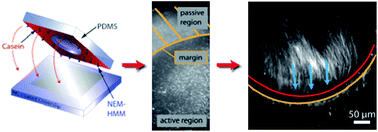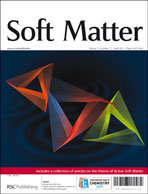Polar pattern formation: hydrodynamic coupling of driven filaments†
Abstract
How order can emerge spontaneously from a disordered system has always fascinated scientists from numerous disciplines. Especially in active systems like flocks animals, self-propelled microorganisms or the cytoskeleton, a unifying understanding of the pattern formation remains elusive. This is attributed to the inherent complexity of most model systems that prevents a thorough identification of the fundamental mechanisms that are responsible for the intriguing self-organizing phenomena in active systems. Here we show that long ranged hydrodynamic interactions play a crucial role in the pattern forming mechanisms in the high density motility assay, a precisely controllable minimal model system consisting of highly concentrated filaments that are driven on the nanoscale. Stability and size of the patterns depend on long ranged hydrodynamic interactions that are self-induced by the coherently moving filaments. The hydrodynamic interactions not only influence the spatial and temporal scale of the patterns but also affect the dynamics of a particular cluster in close proximity to confining boundaries or other surrounding clusters.

- This article is part of the themed collection: Active Soft Matter

 Please wait while we load your content...
Please wait while we load your content...